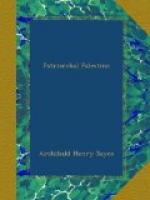’Ammu-anshi married Sinuhit to his eldest daughter, and bestowed upon him the government of a district called Aia which lay on the frontier of a neighbouring country. Aia is described as rich in vines, figs, and olives, in wheat and barley, in milk and cattle. “Its wine was more plentiful than water,” and Sinuhit had “daily rations of bread and wine, cooked meat and roast fowl,” as well as abundance of game. He lived there for many years. The children born to him by his Asiatic wife grew up and became heads of tribes. “I gave water to the thirsty,” he says; “I set on his journey the traveller who had been hindered from passing by; I chastised the brigand. I commanded the Beduin who departed afar to strike and repel the princes of foreign lands, and they marched (under me), for the prince of Tenu allowed that I should be during long years the general of his soldiers.”
Sinuhit, in fact, had given proof of his personal prowess at an early period in his career. The champion of Tenu had come to him in his tent and challenged him to single combat. The Egyptian was armed with bow, arrows, and dagger; his adversary with battle-axe, javelins, and buckler. The contest was short, and ended in the decisive victory of Sinuhit, who wounded his rival and despoiled him of his goods.
A time came, however, when Sinuhit grew old, and began to long to see once more the land of his fathers before he died. Accordingly he sent a petition to the Pharaoh praying him to forgive the offences of his youth and allow him to return again to Egypt. The petition was granted, and a letter was despatched to the refugee, permitting him to return. Sinuhit accordingly quitted the land where he had lived so long. First of all he held a festival, and handed over his property to his children, making his eldest son the chief of the tribe. Then he travelled southward to Egypt, and was graciously received at court. The coarse garments of the Beduin were exchanged for fine linen; his body was bathed with water and scented essences; he lay once more on a couch and enjoyed the luxurious cookery of the Egyptians. A house and pyramid were built for him; a garden was laid out for him with a lake and a kiosk, and a golden statue with a robe of electrum was set up in it. Sinuhit ceased to be an Asiatic “barbarian,” and became once more a civilized Egyptian.
The travels of Sinuhit were involuntary, but a time came when a tour in Palestine was almost as much the fashion as it is to-day. The conquests of Thothmes III. had made Syria an Egyptian province, and had introduced Syrians into the Egyptian bureaucracy. Good roads were made throughout the newly-acquired territory, furnished with post-houses where food and lodging could be procured, and communication between Egypt and Canaan thus became easy and frequent. The fall of the eighteenth dynasty caused only a momentary break in the intercourse between the two countries; with the establishment of the nineteenth dynasty it was again resumed. Messengers passed backward and forward between Syria and the court of the Pharaoh; Asiatics once more thronged into the valley of the Nile, and the Egyptian civil servant and traveller followed in the wake of the victorious armies of Seti and Ramses. The Travels of a Mohar is the result of this renewed acquaintance with the cities and roads of Palestine.




